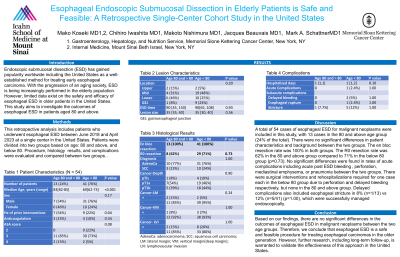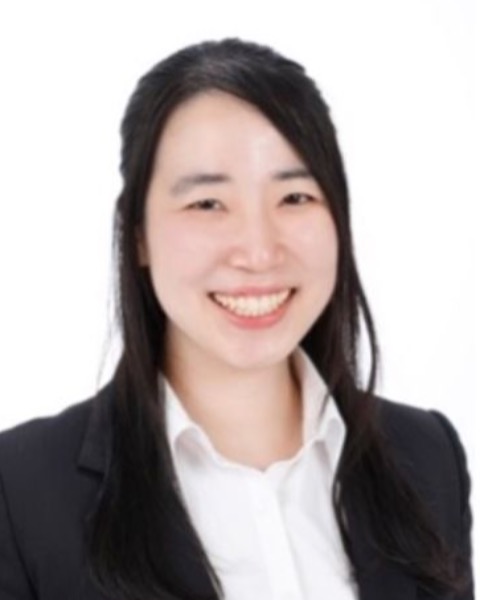Sunday Poster Session
Category: Interventional Endoscopy
P0848 - Esophageal Endoscopic Submucosal Dissection in Elderly Patients Is Safe and Feasible: A Retrospective Single-Center Cohort Study in the United States
Sunday, October 22, 2023
3:30 PM - 7:00 PM PT
Location: Exhibit Hall

Has Audio

Mako Koseki, MD
Icahn School of Medicine at Mount Sinai, Mount Sinai Beth Israel
New York, NY
Presenting Author(s)
Award: Presidential Poster Award
Mako Koseki, MD1, Chihiro Iwashita, MD2, Jaques Beauvais, MD2, Makoto Nishimura, MD2, Mark Schattner, MD2
1Icahn School of Medicine at Mount Sinai, Mount Sinai Beth Israel, New York, NY; 2Memorial Sloan Kettering Cancer Center, New York, NY
Introduction: Endoscopic submucosal dissection (ESD) has gained popularity worldwide including the United States as a well-established method for treating early esophageal carcinoma. With the progression of an aging society, ESD is being increasingly performed in the very elderly population. However, limited data exist on the safety and efficacy of esophageal ESD in older patients in the United States. This study aims to investigate the outcomes of esophageal ESD in patients aged 80 and above.
Methods: This retrospective analysis includes patients who underwent esophageal ESD between June 2018 and April 2023 at a single center in the United States. Patients were divided into two groups based on age: 80 and above, and below 80. Treatment results and complications were evaluated and compared between two groups.
Results: A total of 62 cases of esophageal ESD for malignant neoplasms were included in this study, with 13 cases in the 80 and above age group (22% of the total). There were no significant differences in patient characteristics and background between the two groups. The en bloc resection rate was 100% in both groups. The R0 resection rate was 62% in the 80 and above group compared to 71% in the below 80 group (p=0.73). The median procedure time [IQR, min] was 90 [45, 150] vs 90 [65, 108] (p=0.93). No significant differences were found in rates of acute complications including acute post ESD bleeding[CI1] , perforation, mediastinal emphysema, or pneumonia between the two groups. The median hospitalization period [IQR, days] was 1 [1,1] vs 1 [1,2] (p=0.10). One patient required a surgical intervention (perforation) and another was rehospitalized (delayed bleeding) both in the below 80 group, but none in the 80 and above group. Delayed complications also included esophageal stricture in 8% (n=1/13) vs 12% (n=4/40) (p=1.00), which were successfully managed endoscopically.
Discussion: Based on our findings, there are no significant differences in the outcomes of esophageal ESD in malignant neoplasms between the two age groups. Therefore, we conclude that esophageal ESD is a safe and feasible procedure for treating esophageal carcinomas in the older generation. However, further research, including long-term follow-up, is warranted to validate the effectiveness of this approach in the United States.
Disclosures:
Mako Koseki, MD1, Chihiro Iwashita, MD2, Jaques Beauvais, MD2, Makoto Nishimura, MD2, Mark Schattner, MD2. P0848 - Esophageal Endoscopic Submucosal Dissection in Elderly Patients Is Safe and Feasible: A Retrospective Single-Center Cohort Study in the United States, ACG 2023 Annual Scientific Meeting Abstracts. Vancouver, BC, Canada: American College of Gastroenterology.
Mako Koseki, MD1, Chihiro Iwashita, MD2, Jaques Beauvais, MD2, Makoto Nishimura, MD2, Mark Schattner, MD2
1Icahn School of Medicine at Mount Sinai, Mount Sinai Beth Israel, New York, NY; 2Memorial Sloan Kettering Cancer Center, New York, NY
Introduction: Endoscopic submucosal dissection (ESD) has gained popularity worldwide including the United States as a well-established method for treating early esophageal carcinoma. With the progression of an aging society, ESD is being increasingly performed in the very elderly population. However, limited data exist on the safety and efficacy of esophageal ESD in older patients in the United States. This study aims to investigate the outcomes of esophageal ESD in patients aged 80 and above.
Methods: This retrospective analysis includes patients who underwent esophageal ESD between June 2018 and April 2023 at a single center in the United States. Patients were divided into two groups based on age: 80 and above, and below 80. Treatment results and complications were evaluated and compared between two groups.
Results: A total of 62 cases of esophageal ESD for malignant neoplasms were included in this study, with 13 cases in the 80 and above age group (22% of the total). There were no significant differences in patient characteristics and background between the two groups. The en bloc resection rate was 100% in both groups. The R0 resection rate was 62% in the 80 and above group compared to 71% in the below 80 group (p=0.73). The median procedure time [IQR, min] was 90 [45, 150] vs 90 [65, 108] (p=0.93). No significant differences were found in rates of acute complications including acute post ESD bleeding[CI1] , perforation, mediastinal emphysema, or pneumonia between the two groups. The median hospitalization period [IQR, days] was 1 [1,1] vs 1 [1,2] (p=0.10). One patient required a surgical intervention (perforation) and another was rehospitalized (delayed bleeding) both in the below 80 group, but none in the 80 and above group. Delayed complications also included esophageal stricture in 8% (n=1/13) vs 12% (n=4/40) (p=1.00), which were successfully managed endoscopically.
Discussion: Based on our findings, there are no significant differences in the outcomes of esophageal ESD in malignant neoplasms between the two age groups. Therefore, we conclude that esophageal ESD is a safe and feasible procedure for treating esophageal carcinomas in the older generation. However, further research, including long-term follow-up, is warranted to validate the effectiveness of this approach in the United States.
Disclosures:
Mako Koseki indicated no relevant financial relationships.
Chihiro Iwashita indicated no relevant financial relationships.
Jaques Beauvais indicated no relevant financial relationships.
Makoto Nishimura: Boston Scientific – Consultant. Olympus America – Consultant.
Mark Schattner: Boston Scientific – Consultant. Mirai Medical – Consultant. Novo Nordisk – Consultant.
Mako Koseki, MD1, Chihiro Iwashita, MD2, Jaques Beauvais, MD2, Makoto Nishimura, MD2, Mark Schattner, MD2. P0848 - Esophageal Endoscopic Submucosal Dissection in Elderly Patients Is Safe and Feasible: A Retrospective Single-Center Cohort Study in the United States, ACG 2023 Annual Scientific Meeting Abstracts. Vancouver, BC, Canada: American College of Gastroenterology.

